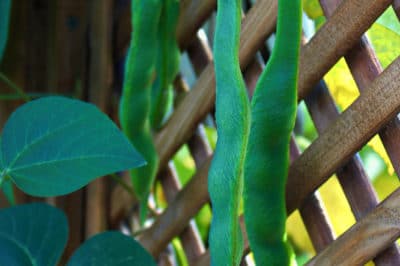Soil Preparation
In most cases, you will need to prepare your soil before you put up a trellis. If you dig or till your soil, you won’t want to be dealing with posts or wire in the way. Add any soil amendments, such as well-rotted leaves, organic compost or aged manure and work them in. Water to settle the soil and make sure the ground is level before you erect the trellis.
Choosing Your Beans
Pole beans may be ornamental, edible or both. You may want your trellis to reflect these factors, with a more decorative trellis for ornamental beans. Among your choices:
- Blue Lake – a classic standard green bean.
- Violet-Podded pole – purple pods turn green when cooked.
- Golden Gate – yellow Romano bean.
- Scarlet Runner Bean – ornamental and edible
- Hyacinth bean – an extremely showy ornamental with purple, pink and white flowers.
Trellis Supports
The most important thing in putting up a trellis is to make sure the supporting posts are well-seated in the ground. The rule of thumb is to put your posts at least two or three feet deep, which means you need at least a 10-foot post. A four-by-four or four-inch diameter post should be strong enough to bear the weight of both trellis and vine. Treated posts will last longer.
Preparing the Post Holes
Make sure your post holes are wide and deep enough. Many gardeners put a layer of gravel in the bottom of the hole to promote drainage, or embed the posts in concrete. This adds to the required depth. It’s hard to tamp dirt in a narrow hole; well-tamped dirt means the posts will be more secure. For a four-inch post, dig a hole at least two feet wide.
Securing the Trellis
What you use for a trellis can affect how you secure it to the posts. A metal fence panel or wire fencing can be stapled into the wood. Fence panels can also be wired to the wood with heavy-duty wire. A trellis of latticed wood can be nailed or screwed onto the fence post. Whatever you use, make sure it is securely fastened. Bean vines are heavy, especially when wet.
